Red Cabbage Sauerkraut with Fermented Beet
Homemade sauerkraut is the best fermented food to make if you’re new to fermenting vegetables at home. This red cabbage sauerkraut is particularly easy for a first fermentation project since cabbage ferments exceptionally well. Cabbage’s water content and microbial species richness make it optimal for wild fermentation! This recipe teaches you how to make probiotic red cabbage and beet sauerkraut with ginger in a mason jar.

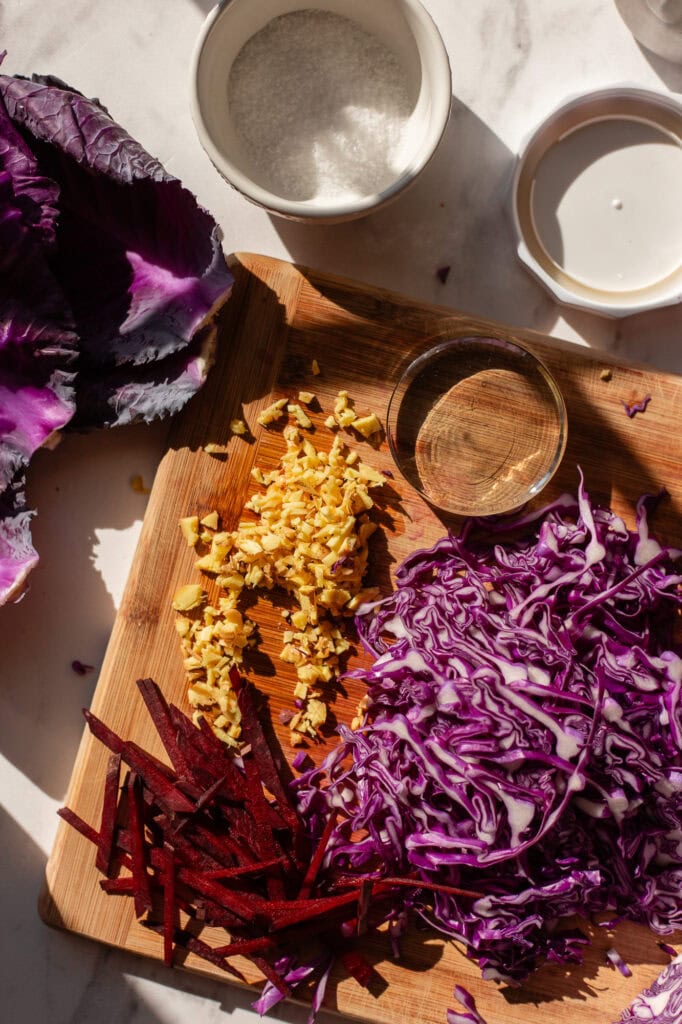
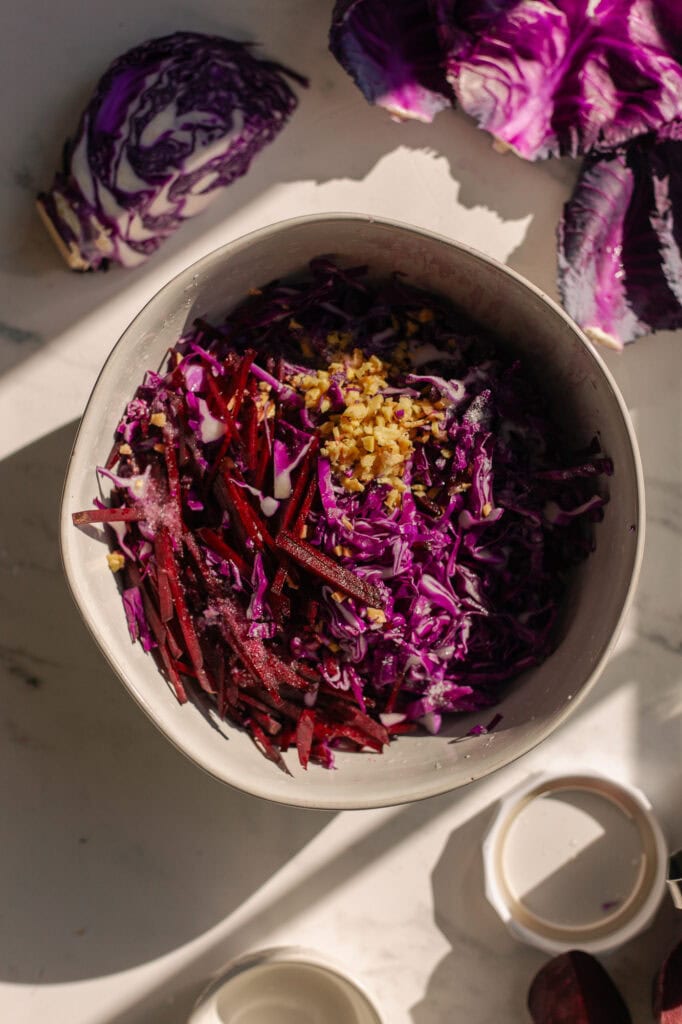
Can you make sauerkraut with red cabbage?
I love ginger beet sauerkraut with red cabbage. Some people call it purple cabbage, but it’s the same thing. It’s especially great for fall and winter, aka cold and flu season, since it’s so packed with antioxidants. With just a few simple ingredients and a few weeks of fermentation, you can craft a nutrient-dense, probiotic, flavorful sauerkraut.
The key point is that red cabbage and beets are higher-FODMAP ingredients. This means there’s more sugar in the mix than with something like Jalapeno Sauerkraut. As long as you use the recommended amount of salt, keep everything submerged, and keep the lid clean, you shouldn’t have any issues.
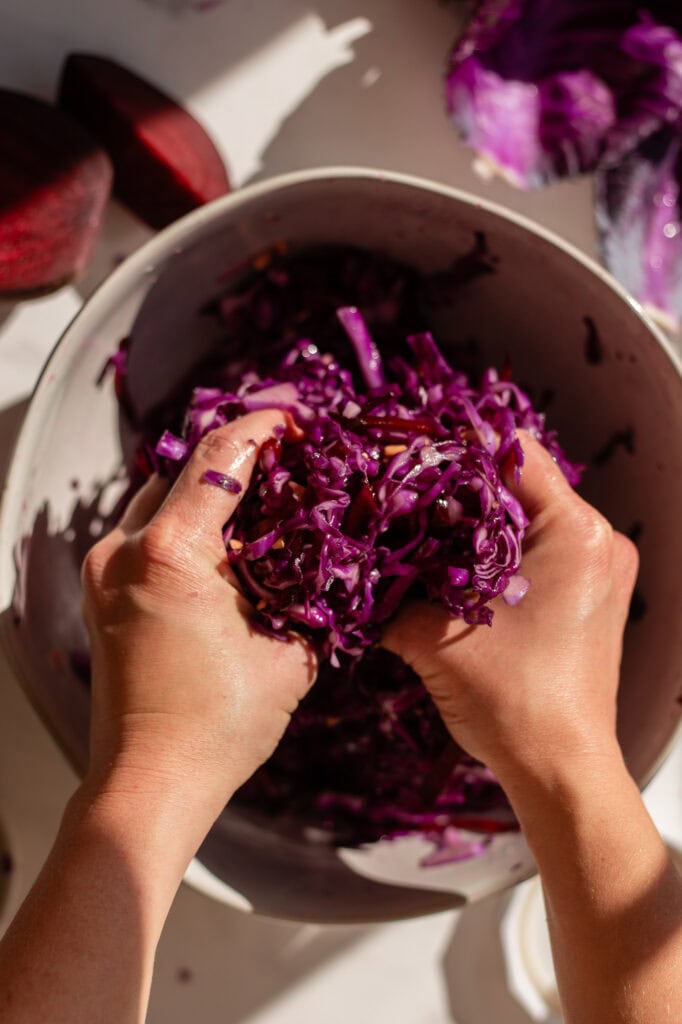
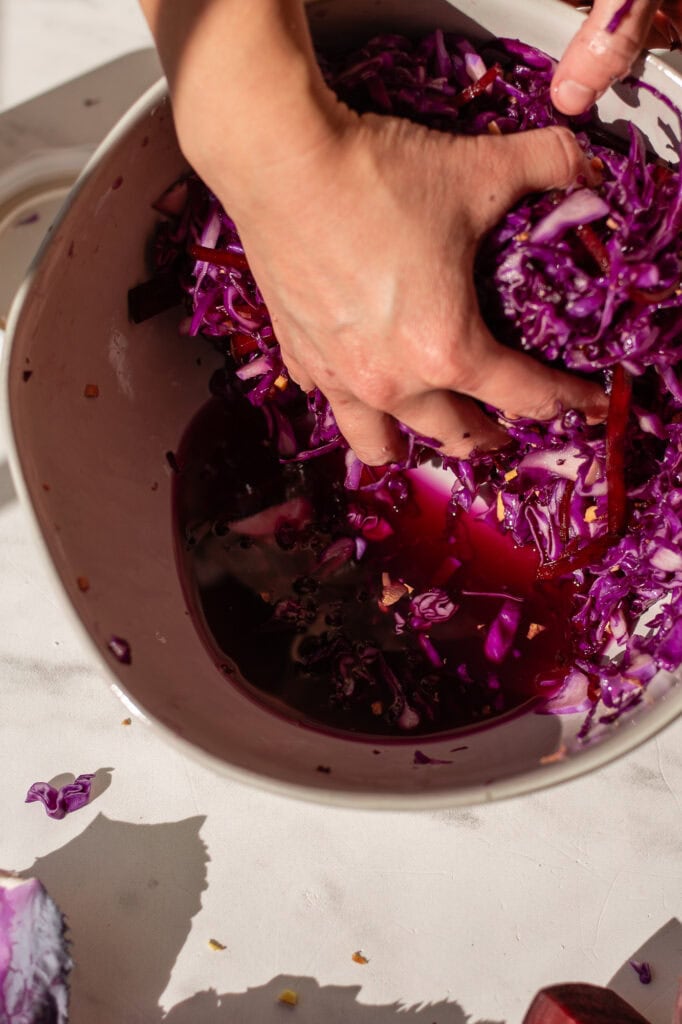
Supplies
Red Cabbage Sauerkraut Fermentation Timeline
Note that temperature will influence how fast or slow sauerkraut ferments. This timeline is applicable between 70-80° F. If you keep your home colder, the process is slower. If your home is warmer, it will be faster.
- 24 – 48 hours: All contents in the jar should be submerged beneath the brine. At this time, there are still Gram-negative bacteria and possible pathogens present. (not to worry, any unfriendly microbes die off quickly!)
- 48 hours – 5 days: After 48 hours, you should start to see lots of bubbles being produced, and the color will change from deep purple to a lighter reddish magenta. This is when the ferment enters stage two of vegetable fermentation. Leuconostoc bacteria begin to thrive, and Gram-negative organisms die off.
- 5 – 10 days: The bubbles in the brine will decrease as the ferment leaves stage two and enters stage three. The ferment will become cloudy, the color will change, and a pleasant sour smell will develop. You should also recognize some earthy beet smells. Lactobacillus species begin to thrive at this time.
- 10 – 21 days: Next, Lactobacillus makes up most or all of the microbial population. They produce copious amounts of lactic acid, making the fermented cabbage smell even more pleasantly sour. This is when the cabbage mixture becomes sauerkraut and is preserved.
- 21 – 28 days: This is when you want to smell and taste test. Wait for the kraut to smell and taste as you like, and refrigerate when you find the smell and taste most pleasant! We like ours best when we refrigerate at about 25 days.
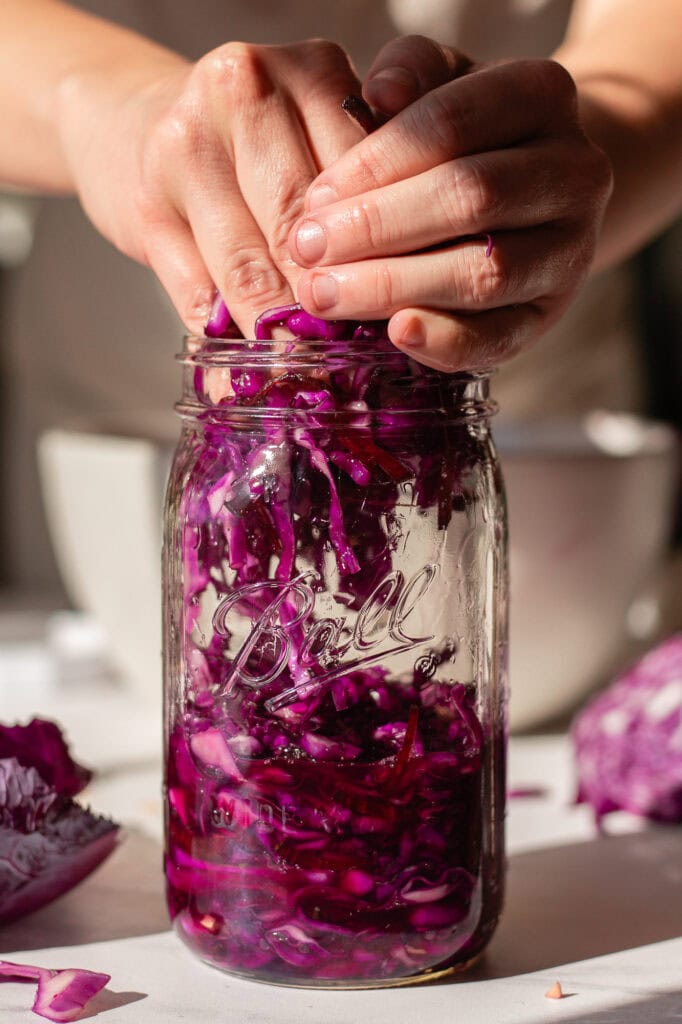
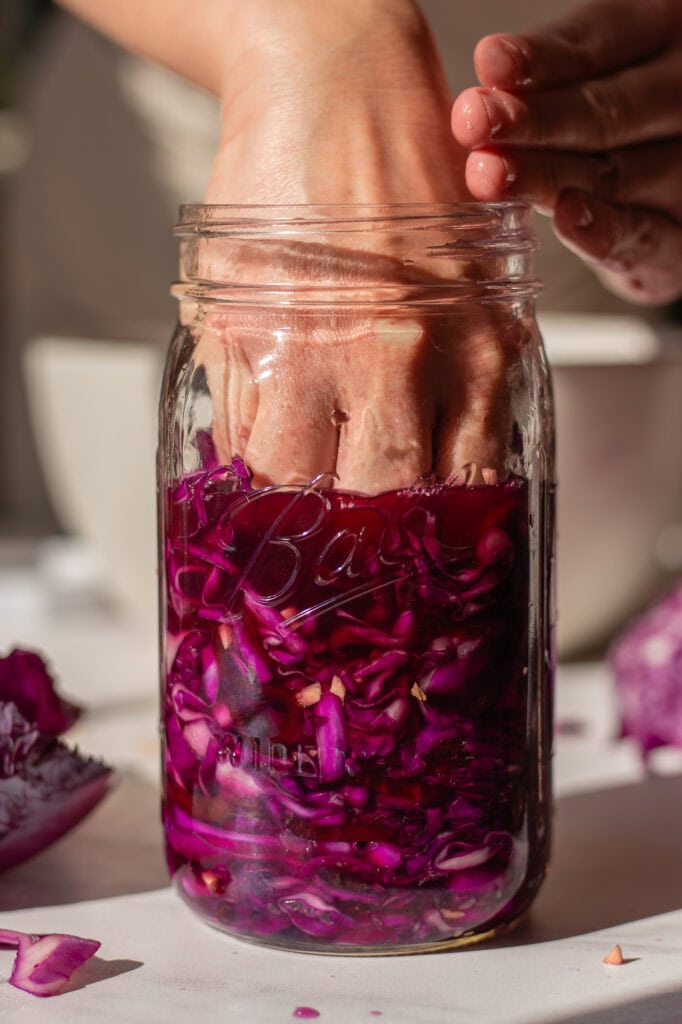
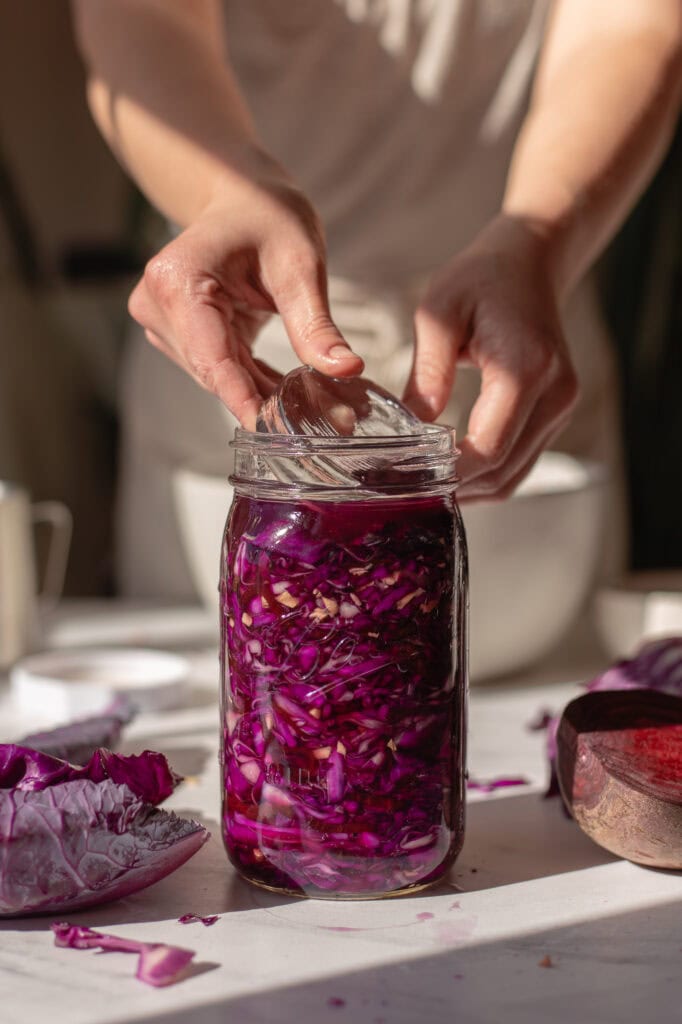
What Temperature Should I Keep My Red Cabbage Sauerkraut At?
Keep your fermenting cabbage at a temperature between 70-80 degrees F. Keep out of direct sunlight. If it’s winter and your kitchen get’s below 70, don’t fret! It’s fine to ferment in colder conditions; it will just take longer to finish fermenting.
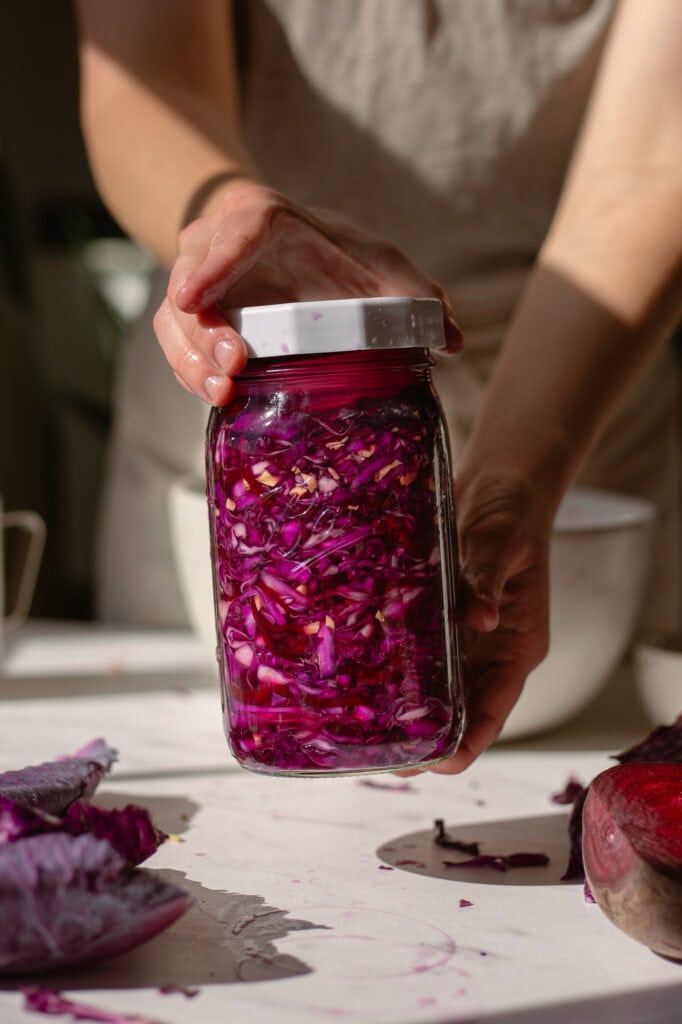
How Long Should I Ferment Beet Sauerkraut?
After 3-4 weeks, remove the fermentation weight, smell, and taste test. Your fermented cabbage should smell pleasantly sour and taste tart, lightly salty, and beety + cabbagey.
Do I Need to Refrigerate Beet Kraut?
After fermenting for 3-4 weeks, remove the weight and place a regular mason jar lid on the jar and refrigerate. Consume within six months for full probiotic benefits.
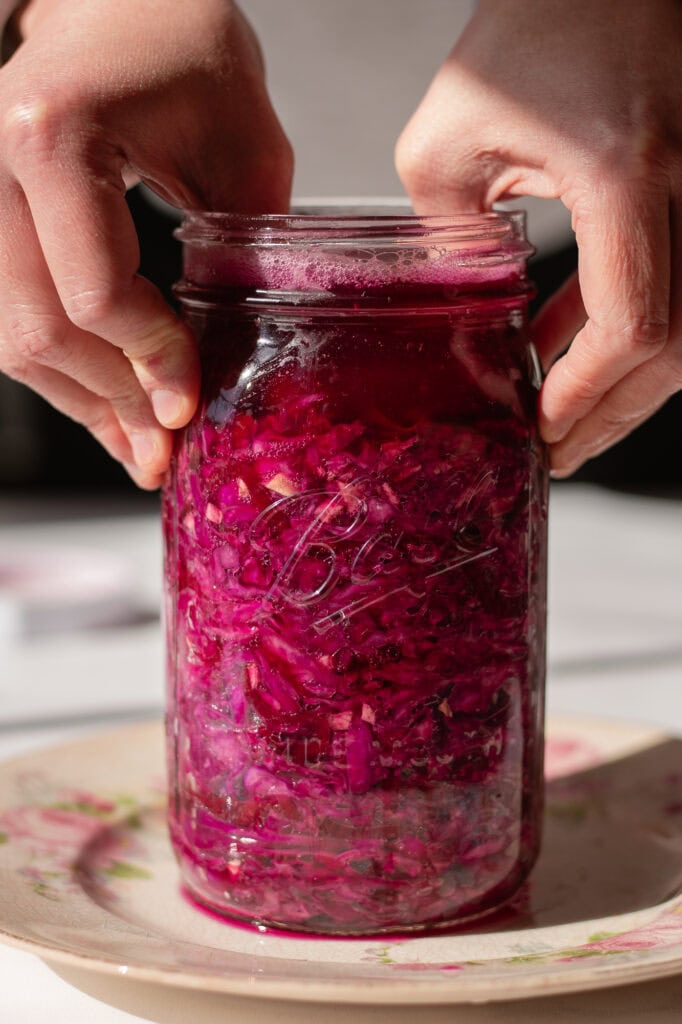

Homemade Beet and Red Cabbage Sauerkraut Tips
- During the first few days of fermentation: carbon dioxide and bubbles will be produced. Sometimes jars will become full of liquid, which can seep out. Keep the jar in a bowl of dish to catch spills. Remove the lid and tamper everything back down using a gloved hand, tamper, or spoon. You can rinse the lid with hot, soapy water to keep it clean. Ensure everything, including the weight, is submerged below the brine and replace the lid to continue fermenting.
- Always Trust your sense of smell: Fermented cabbage should smell pleasantly sour and like strong cabbage. Never eat anything that smells repulsive or yeasty.
- Never eat anything with mold growing on it: You should not encounter this problem if you follow directions. Ensure you use high-quality, organic beets and ginger root. Roots grow under the soil, and it’s best to use ingredients from healthy soil.
- Taste test at three weeks: If you prefer the sauerkraut to be more tart and sour, let it ferment at room temperature longer.

Fermented Beet and Red Cabbage Sauerkraut with Ginger
The fermented beet and red cabbage sauerkraut recipe is the best way to make fermented beets and cabbage. This beet sauerkraut is great for beginners and is ready to eat in three weeks.
- Prep: 15 Minutes
- Total Time: 15 Minutes
Ingredients
- 500 grams red cabbage
- 100 grams shredded beets (organic)
- 1 Tablespoon fresh grated ginger (organic)
- 20 grams sea salt
- 200 grams filtered water
Instructions
- Wash your fermentation equipment (jar, weight, and lid)
- Remove the outer leaves of your cabbage and lightly rinse the cabbage, beets, and ginger with cool water.
- Chop the cabbage and beets and grate the ginger.
- Place your kitchen scale on the counter. Turn it on and set it to weigh in grams.
- Measure out all of your ingredients using your kitchen scale.
- Mix all the ingredients, including the water, in a large bowl. Lightly massage the cabbage and break up any large pieces.
- Pack it all, including the water, into a clean jar with a rust-proof lid. (a 32-ounce jar works best)
- Place a fermentation weight in the jar, making sure to submerge the cabbage pieces and weight fully into the liquid. If you don’t have quite enough liquid, place your glass fermentation weight in the jar and submerge as much as possible. Over the next 12 hours, the cabbage should release more liquid and you can press the fermentation weight down below the brine.
- Secure the lid (You do not need to tighten it all the way. Just secure the lid but leave it ever so slightly loose, so the gas doesn’t build up too much). You can keep the jar in a glass dish to catch any spills.
- Burping the jar: It should get bubbly in the first few days, and the color will change. If you have a tightly secured lid, you will need to burp the jar. You should also wash off the lid to keep it clean and re-adjust the fermentation weight whenever needed. Anytime the weight comes up out of the brine, with clean hands press hard on the weight to tamper everything back down into the liquid.
- Ferment at room temperature for 21-28 days, then remove the fermentation weight and refrigerate.
- If you try this recipe and love it, please leave a five-star review below!
Notes
- This recipe contains roots/rhizomes (beets and ginger). It’s essential to try to use organic roots from high-quality soil in fermentation. Conventionally grown roots from poor-quality soil can lead to mold.
- See fermentation tips and timeline above this recipe.
- Taring/zeroing the scale with a container on it subtracts the weight of the container, allowing you to weigh only what is added to the container. After taring/zeroing the scale, the scale should read 0.0 with the container on it.


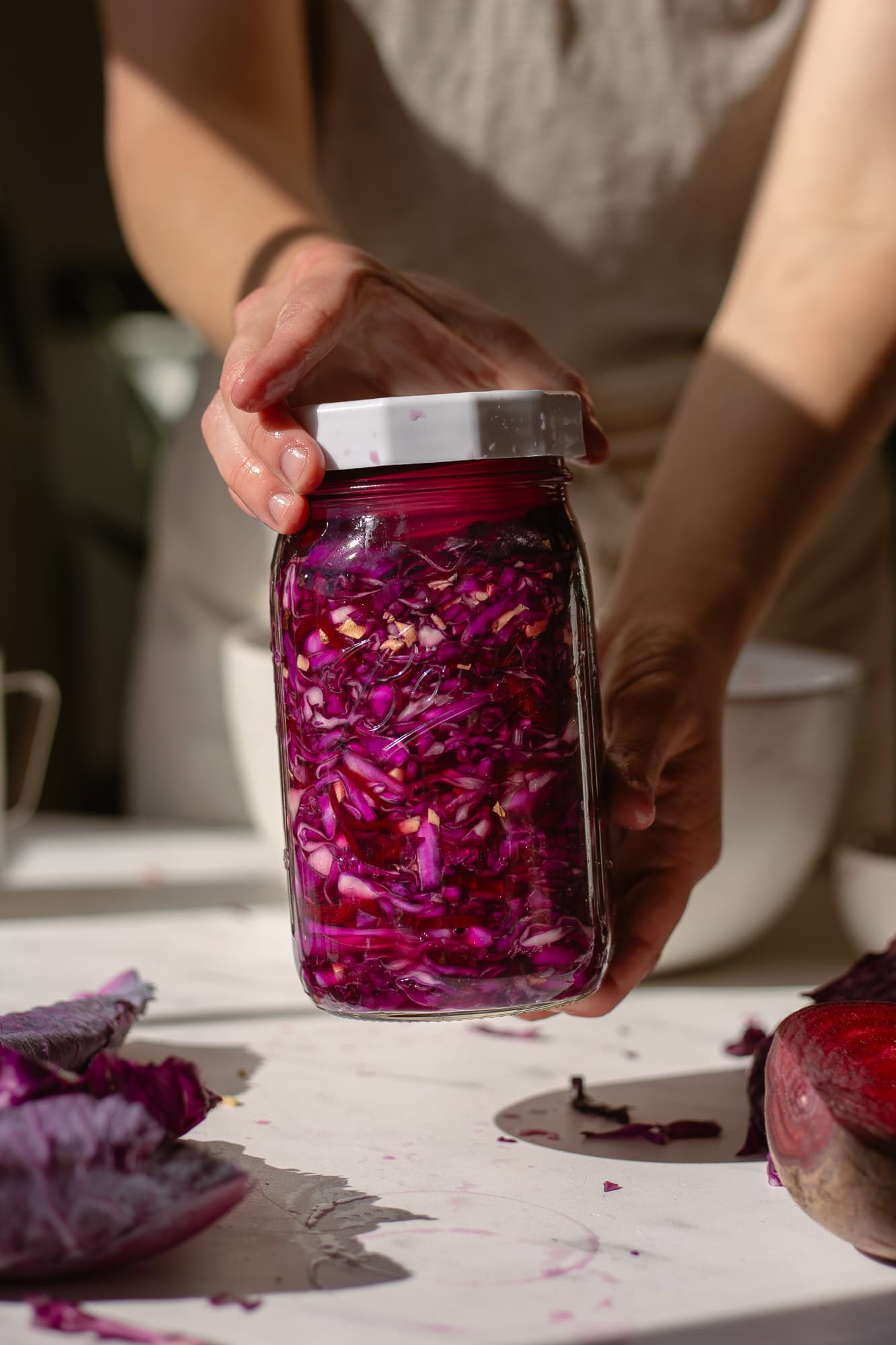
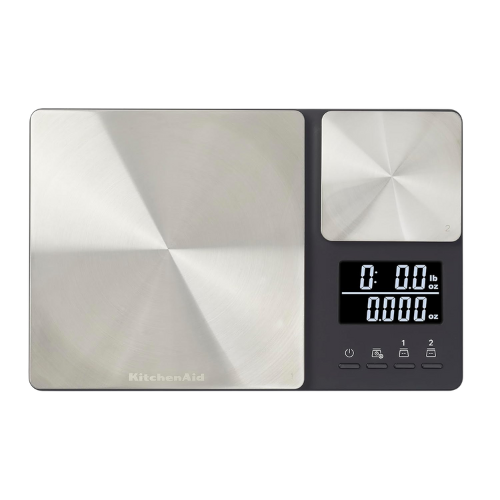
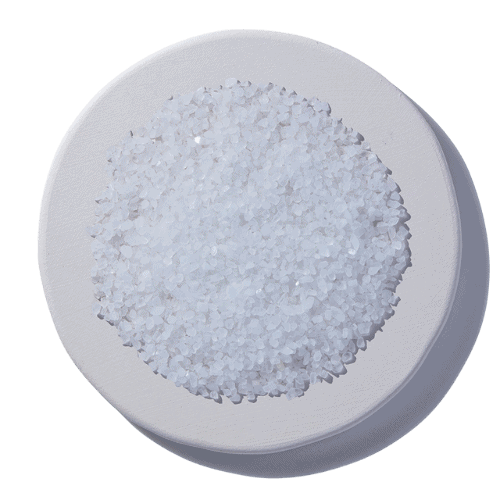

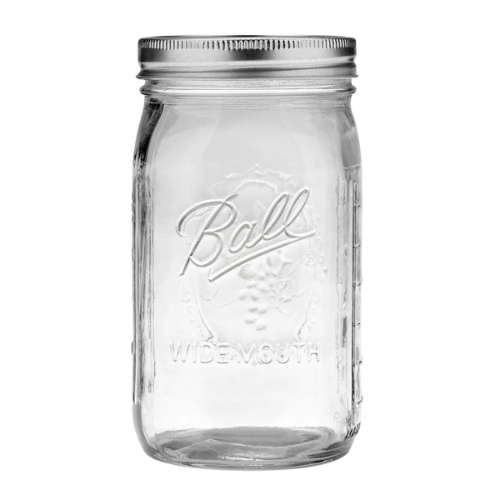
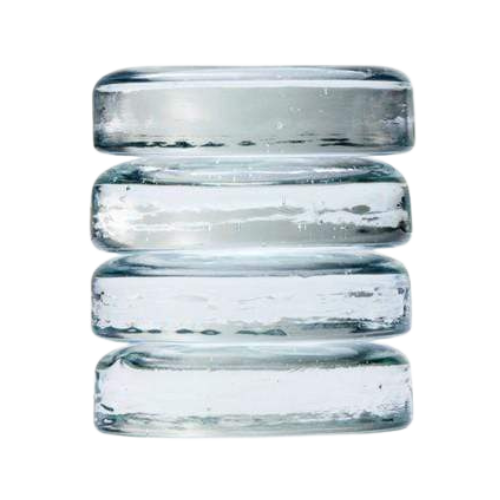



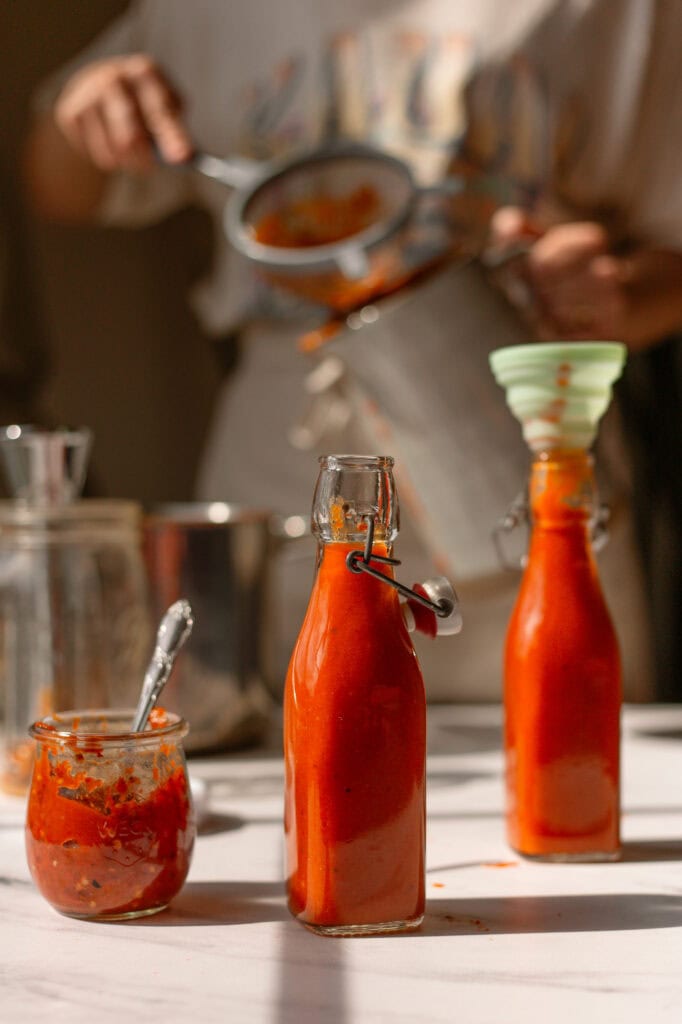








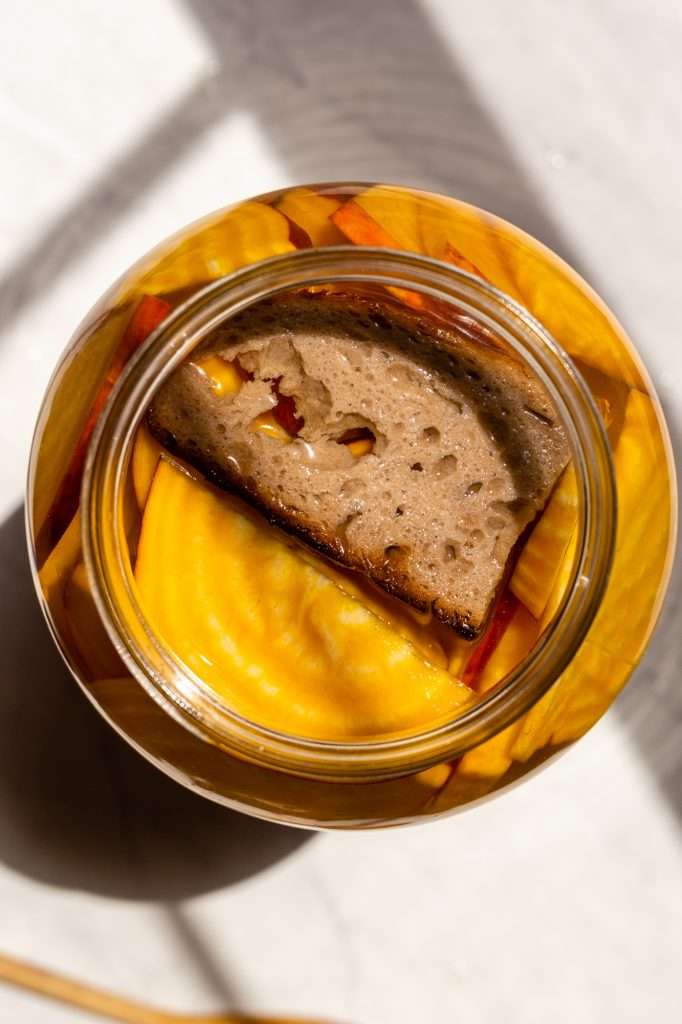


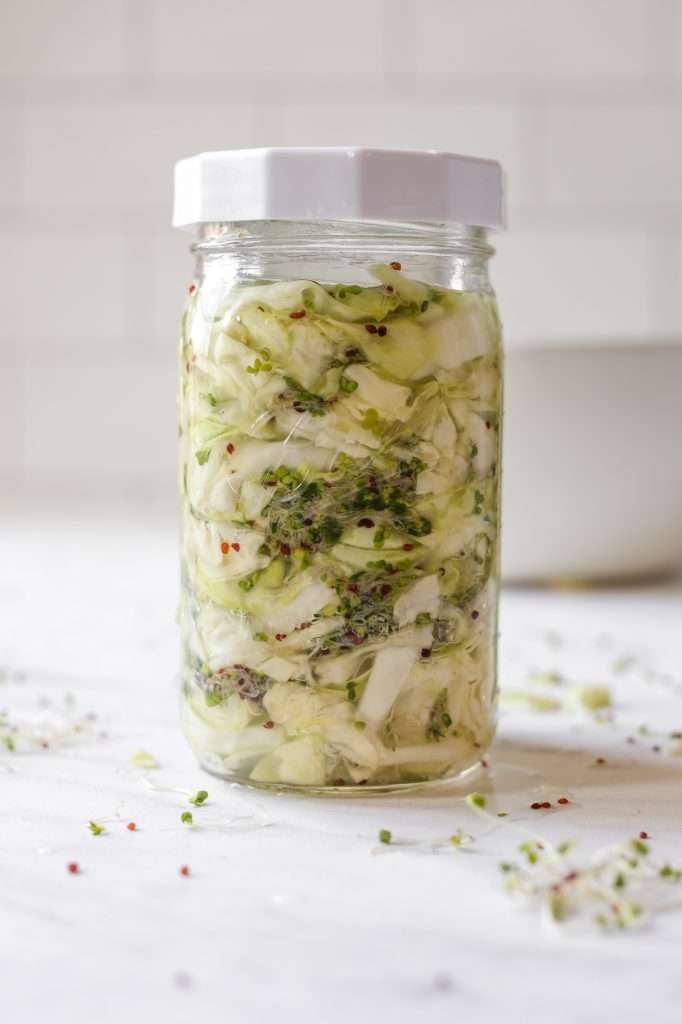

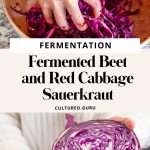
Good morning.
Just discovered your site and am enjoying looking around. I have some red cabbage and beets to use up and I have a question regarding your recipe. All our batches of various krauts we’ve used 2-2.5% salt, based on the weight of the vegetables. We let the cabbage and veggies make their own brine and haven’t needed to add water. Your red cabbage recipe calls for approx 3.3% salt, based on ingredient weight. I’m wondering if we could simply use 3.3% salt and let the ingredients make their own brine. Thanks for your thoughts.
Stan
This recipe is a 2.44% total salt concentration. Looks like you used a severely inaccurate calculation to arrive at 3.3%. The mathematics of calculating salt concentration is fully explained in the body of this blog post. Water is also an ingredient that has to be weighed to calculate total salt concentration. 20 grams of salt/ 820 grams of total ingredients = 2.44%
It is an option to allow the cabbage to make its own brine. However, if anyone who is using an old cabbage, an out of season cabbage, or a cabbage thats been in their fridge too long they will not have enough liquid to keep the contents submerged for the duration of the fermentation. Keeping vegetables submerged is of the most important in safe vegetable fermentation. Our recipe methods are designed for consistency amongst all of our blog readers, regardless of the state of their ingredients.
I let my cabbage make its own brine. I never need to add water. I’m excited to try her recipes, but just knew I would not add any water.
All my sauerkraut recipes are formulated with water to account for regional and seasonal variations in cabbage water density. Basically, it ensures enough brine and cuts down on problems, especially for beginners. You should follow the recipe as written.
I plan on making this for the first time today from the cabbage we grew. For the beats, above it says shredded beets and then underneath that it says chop the beets. Wondering if I’m shredding them or chopping them, I assume shredding? And also am I peeling them or no? I can’t wait to try this in a month and rate it. I love your recipes!
you can chop, grate, cube, whatever you like best. You can leave the skin on if you wash the beets well in cool water. Peel them if you prefer!
Hi! This looks really good. I was wondering if you use cooked or raw beets? Thanks!
I used raw beets that had been frozen in this recipe.
I just got a fermentation crock with a lid.ñ from a talented local potter. Can I use it for this recipe instead of a mason jar?
Oh, that’s wonderful! I hope to buy myself a beautiful, custom ceramic crock one day! Yes, you can use it. Just note the volume and scale up the recipe as necessary. You can double or triple the recipe using the buttons on the recipe card. This recipe at 1x is for a 32-ounce jar. Oh, and you should still use a fermentation weight and keep everything submerged in the brine.
Thanks! Excited to try this recipe- is it ok if I don’t fill the crock as long as it stays submerged?
Yes, that should be fine. If your crock has a water-seal top, use that as well, in tandem with submerging. 🙂
We love this! I made 2 quarts and I mixed the ingredients gently in hopes that it would still have some crunch to it. I fermented them for the full 4 weeks and they turned out great …. crunchy and so flavorful!
Kaitlynn, I don’t know how you managed to keep your white sweater so clean when you were making this. I wore a black tee shirt and I’m glad I did!
Thanks so much for sharing this great recipe.
So happy to hear you tried another recipe and loved it, Lou! Jon says that I have surgeon’s hands, so I guess my steady hands helped keep my sweater stain-free haha!
Fantastic recipe, made it yesterday for my birthday. Only 20 days left to taste test. I am having issues with my cucumbers, which I make into sour pickles. Its 90° in the Philippines so fermentation happens rapidly. Although I end up with very sour pickle spears they are not crispy, even though I add in bay leaves (as well as peppercorns/coriander/mustard seed) and very fresh cucs. 3.5% salinity. Can you tell me what I’m doing wrong? Thanks!!
Hey there,
I responded to the question you left about pickles on our wild fermented dill pickle blog. Yes, a high temperature does speed up the fermentation timeline. Fermentation temperatures above 80-85° F can lead to vegetable softening. I also suggest a 3-4% total salt concentration (which is not the same thing as salinity).
This recipe sounds great I tried a kraut with similar ingredients recently and have wanted to recreate it since! Just wondering can this be done without a fermentation weight? I don’t have one and am very new to fermenting but wondering if I keep the veg fully submerged and the lid of my jar airtight will that work? Thanks in advance!
It’s best to use a fermentation weight, but it is possible to still have good results without one. You must make sure everything is staying submerged for the duration of the fermentation process though. When it gets bubbly, you will have to check it very often to resubmerge everything with a clean utensil.
Hi, I followed your recipe exactly using 50% of all ingredients and added it to a 0.5 L (17 ounce) Kilner jar. With a weight added, the tightly packed food was submerged in the brine. The brine came up to the very top of the jar, meaning there was no air under the lid. Is this okay, or should I tip some away to allow for some air? Your blog indicated some bacteria use oxygen in the early stages of fermentation. Can this be extracted solely from the water? Thanks Steve. NB: I live in England and am very grateful you give metric measurements as I find the Imperial system quite baffling!
Hello! yes, that sounds like the right amount of brine, and no need to tip some away. In the very beginning of fermentation, some microbes do use oxygen, but they’re using dissolved oxygen within the water… and that’s how the brine becomes anaerobic. Just make sure you place your jar in a glass baking dish or a bowl because when it gets bubbly some brine will seep out.
The metric system is the only way to go, especially for fermentation! I hate customary and imperial units haha
Many thanks for your response. Greatly appreciated! Another question if I may? Fermented vegetables such as sauerkraut and kimchi have gut-friendly probiotic bacteria. I understand these will pass naturally into our microbiome when the food is consumed raw. Are these bacteria destroyed if the food is subsequently heated, which you might do if serving a hot meal? Many thanks. Steve
This was my first attempt at fermenting anything … and I am delighted with the result. After 25 days, I have a quite sour, crunchy, fresh Kraut with overtones of ginger. I am very grateful for Kaitlynn’s blog and her responsiveness to my question. Many thanks.
Do you have to use previously frozen beets?
no, you can use fresh beets.
Did you freeze your beets raw or were they sliced/blanched or processed in some way?
they may have been blanched! I’ve used organic frozen beets from the store, not sure how they process those.
Hi Kaitlynn- questions for you. I love a kraut from Wildbrine that is similar to this recipe but they also included pear with the beets and red cabbage. I would love to make my own version but am wondering if I add some pear to this recipe can I keep the amount of other ingredients the same? Or would I keep the weight of the beets and pear together to 100 grams? If not, what would be your suggestion on how many grams of pear to add?
Newer to fermenting so I appreciate any advice!
Hi there!
You want to keep the weight of the beets and pears together at 100 grams.
I hopped on this site loving that same Wildbrine kraut and am so thankful for your Q and Kaitlynn’s answer 🙂
Also looking for this Wildbrine recipe! Thanks!!!!
Hi! Is it possible to leave the beets out or to substitute for an equal weight of additional cabbage? Thanks in advance!
absolutely!
JBETHMANN, me, too! I just love that WildBrine Kraut. Sprouts quit carrying it, & the other 2 stores that carry it don’t always have it in stock. It is the yummiest!
The way I make kraut, I don’t know until the end how much water I’ll need. I wonder if making a 2.5 concentration of brine, I can just add as much brine/water as needed once my jar is packed with cabbage. Of course, I would have used the proper amount of salt for the cabbage earlier. Your web site is a game changer and quite possibly a life saver! thank you so much.
My recipes are tested to fit a quart mason jar. But yes that should work! as long as you account for salt with the cabbage weight too.
Do you just use a regular canning lid?
Also, would I be able to reuse the plastic jar from Wildbrine to make the kraut?
There is a list of recommended equipment above the recipe card in the blog post. I do not suggest fermenting in plastic.
The first time I made this I just made one quart. It was so good that it didn’t last long. Just started a half gallon jar. Great recipe and so different from regular sauerkraut.
In step 16 it is suggested that one “place a standard mason jar lid” on the soon to be fermenting cabbage. Would it not be better to use a pickle pipe airlock during primary fermentation and then replace that with a Ball Plastic leak proof lid when placing it into the refrigerator? A standard lid has no way to drive off gasses. One would have to manually burp the stuff otherwise.
No, it would not be better. Solid lids with burping work best. Those silicone lids are awful and cause mold and issues for most people.
After day 24-28 hours I did not notice any bubbles but I opened the jar to push down the weight. Did I mess it up? Am I only supposed to open the jar when it is bubbly? I also wanted to ask if it is okay if tiny pieces are floating at the surface? I used the weight to submerge all the ingredients that I could but I noticed a few tiny floaty pieces around 24 hour mark which is why I opened the jar to remove the small pieces. Did I mess up the process by opening the jar without it being bubbly? I hope these questions make sense.
You didn’t mess it up. It’s perfectly fine to open up the jar and adjust the weight, even if it’s not bubbling yet. You’re doing great!
I’m excited to taste this in a few weeks! I am concerned about be lack of space I have in the top of my jar compared to yours in the picture. Everything is submerged, but my jar is filled to the top with the weight. Do I need 1-2 inches of space at the top? Should I scoop some out to make space?
Hi
I just made one jar of this! Thank you for your specific instructions. I’ve made something similar last year and it wasn’t good, went bad and what I realize is that you weigh EVERYTHING and others just say ONE CABBAGE well, what does that mean !?!? How much weight? How many cups? UGH! So thank you! I want to make another jar but without beets which means I sub that for more cabbage but can I add fresh garlic and a spicy pepper, if so how much is safe?
you can sub the weight of the beets for some garlic and spicy pepper!
Excellent recipe with lots of helpful information! I have 2 questions:
1. Can I make this recipe with 600g beets and no cabbage? If not, what ratio can I use to increase the ratio of beets?
2. I made the recipe as is, and the liquid level bubbled over for the first couple of days, but then depleted to about halfway up the jar, so the top half is not submerged in brine. What can be done to salvage this/prevent this from happening?
I wouldn’t do only beets. They usually have way more sugar than other vegetables, so it makes the fermentation process less reliable. At most I would try half beets half cabbage. The cabbage helps balance out the microbiome so fermentation goes well.
Any time it’s super bubbly and you lose a little brine, you can open up the jar and tamper everything back down with a clean utensil. tampering it back down should make the brine level come back up and cover the cabbage.
Hello there! I just came across your website when I was looking for a red cabbage and beet sauerkraut recipe. I have never fermented before, and I am looking forward to giving this a try!
I was wondering if I can add red onion and garlic to this as well? Thank you!
Amy S.
sure. If you’re only adding a little bit, you can just add in the onion and garlic without needing to adjust the recipe. If you’re adding a substantial amount of garlic and onion, replace a bit of the cabbage weight with the same weight of garlic and onion.
Hi Kaitlynn, thank you so much for all the knowledge you shared on the website and all the wonderful recipes. I have tried few other recipes with success and loved. I tried this fermented red cabbage and beet a week or so ago and maybe I packed it too full, I had a lot of leftover brine but didn’t keep it. Few days after I started, the brine seeped out and the top part of the cabbage and beet turned black and brine level were only half way up the jars. I made more brine according to the salt and water ratio and fill the jars and took out the weight. Few days later now and they dry out again. I use screw on lids but did not screw on tight. I do live in dry climate and wonder if I should keep filling with brine water and if the cabbage is still good. They were dry for at least a few days and the top turned black. Smell fine to me. 😁 I made three jars and half way through…. It would be very wasteful to throw them all away but I don’t want to get sick from spoiled food either. Thank you!
You should not be adding in more brine as you go because the fresh brine is oxygenated and will keep decreasing the acidity of the sauerkraut. If something like this happens you should open up the jar and tamper everything back down to get the brine level to come up again.
Hi! I love your blog, and have tried the traditional sauerkraut and it was delicious. I Just made a big batch of this red cabbage recipe a few days ago and now i have noticed there is some Brown ish foam on top of the ferment. Should i remove it, and is the ferment still safe to eat?
you can scoop the foam off. The brownish color is from the breakdown of the purple color compounds.
Delicious recipe!! I had a majority of the brine bubble out in the first week. Enough still to cover the kraut- but not any extra.
Is it ok to add more water now that it is in the fridge?
Question please. Day three of the fermentation, mixture is bubbling nicely. But it’s so salty! Measured everything precisely with commercial kitchen scales, but in all my previous kimchi and kraut making I’ve soaked the cabbage in brine then rinsed before placing in the pot. Will the salty taste fade during fermentation?
It should be a little less salty than seawater, and a little less salty but similar to brined olives.
I loved your Bavarian style kraut so much! This is my first time trying this recipe. After a few days some liquid has overflowed from my jar and the cabbage at the top has started to look brown, like it’s oxidizing. I just pressed the weight back down so it would be under the brine again. Is browning at the top a problem?
The brown color is just from it rising up out the brine. Super common with purple cabbage. Should be fine. You can scoop the brown bits out. Test the pH at the end with a pH strip if you have any concerns!
I just made this recipe and carefully measured everything. The brine doesn’t cover the cabbage though. Should I make and add more brine?
no, more water will be drawn out of the cabbage over the next few hours. Just open up the jar and press down hard on the weight and the brine level should come up.
This one was REALLY bubbly and pushed out about 1/3 cp of liquid by day 3. I tamped it down to get everything submerged again, should I add more liquid of any sort?
Thank you for providing such good info and great images. Beautiful.
Hello!
I made the fermented beet and red cabbage sauerkraut on May 31 and it seemed to be doing well for a while but then the liquid in the top quarter of both jars has turned a displeasing brown colour. As well, the cabbage at the top is turning a brownish colour as well. Everything is submerged.
Is this normal? Or is this showing something is off?
Thanks for your thoughts and thank you for all of your wonderful recipes!
Gwyn 🙂
this is normal with purple cabbage! It’s the anthocyanins oxidizing at the top a little. Not harmful. I usually just scoop out any brown bits.
Ok wonderful, this is great news! Do you wait until it’s done fermenting to scoop the brown bits out? Or do you do that beforehand? And the brown kraut juice, do you discard this as well? Thank you so much!
I have a question regarding they type of jars used. Can I use the clip-top jar instead of the Ball canning jars for fermenting? You said to not secure tightly, but this isn’t possible with the clip top lids. Should I just burp the jar more often??
Like a weck jar? yes, those work great. I usually leave the gasket off so its self-burping
Hi, I made this recipe exactly as written. For the first few days, it was bubbling like crazy, now it has stopped. Is that OK?
Hi! I just made this and spilled the brine when trying to pour it in. Can I remake it with the same measurements and top off my jar? Thank you for this recipe! I’m a first timer but very excited.
If you just started it, you can mix 2.5 grams of salt per 100 grams of water to make a brine, and top it off. Only do this if you just started it in the last two days though.
My wonderful work colleague has been supplying this goodness to me for the last few weeks now. And it is sensational!! Please everyone do yourself a favour and make this ASAP! Life changer
Hi Kaitlyn, thanks so much for this recipe. I’m based in the south of New Zealand and tried this recipe during our winter months. It would have been less than your recommended 70 degrees for much of the fermentation period. I have left the sauerkraut for around 6 or 7 weeks before putting it in the fridge. It tastes amazing, but just thought I would check if there’s any issues or risks with a longer fermentation period in cold climates? Thanks, Jayne
no risks at all! Sounds like you did it just right!
Thank you so much for your wealth of information, Kaitlynn. I usually use a starter culture with my ferments. Would I still utilize your salt % figuring method with my starter culture? (I’m used to using 3 T. salt for 5 lb. vegetables with 3 c. water plus 3/4 T. per 1 quart of additional brine water needed, but I prefer your instructions with the mathematical percentages.) I actually make myself eat fermented vegetables for their benefits, but I don’t like the taste/saltiness at all. I was hoping in my research, to find the lowest salt concentration rate I could use that was proven safe. I’m looking forward to trying this recipe; thank you again!
The lowest I would recommend using is 2% total salt! so that would be: (weight of all vegetables + weight of water) X 2%
Unfortunately this resulted in a layer of mould for me even on the liquid so I’m not sure what went on (I’ve made lots of sauerkraut before)
so sorry it didn’t work for you. Mold is usually from not keeping the lid clean and not keeping everything submerged. Since this recipe incorporates root vegetables, which grow under ground (where fungi naturally live), you need to be extra sure your ingredients are good quality too.